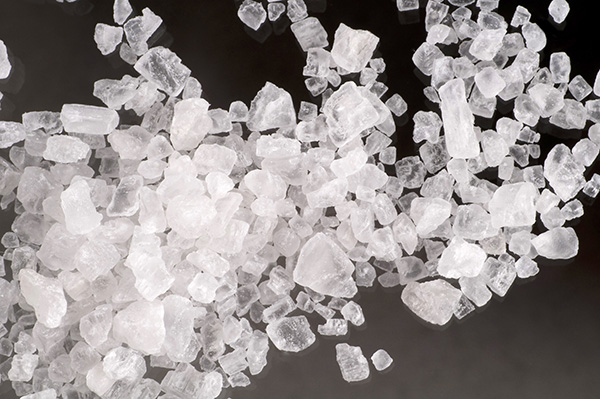What do salt crystals look like?
Sodium chloride crystals are cubic in form. Table salt consists of tiny cubes tightly bound together through ionic bonding of the sodium and chloride ions. The salt crystal is often used as an example of crystalline structure. The size and shape of salt crystals can be modified by temperature. Sodium chloride is available in several different particle sizes (gradation) and forms, depending on what the intended end use is.

Different types of crystals also have different uses. Discrete salt crystals can be seen in rock salt used for deicing. Fine granules are typical of what is used for table salt and even finer popcorn salt. Kosher salt, pickling salt and ice cream salt are slightly coarser. Small compressed pellets are what is used in water softeners and large salt blocks are what is used as salt licks for livestock. When viewed under strong magnification, all sodium chloride is crystalline. Very large cubic crystals, of two, three or more inches in size, can be seen in some salt mines. They are transparent and cleave into perfect cubes when struck with a hard object.
Salt varies in color from colorless when pure, to white, gray or brownish, which is typical of rock salt (halite). Chemically, salt is 60.663% elemental chlorine (Cl) and 39.337% sodium (Na). The atomic weight of elemental chlorine is 35.4527 and that of sodium is 22.989768. Properties of salt are collected in the U.S. Occupational Safety and Health Administration (OSHA) Chemical Sampling Information database.
The world's top five producers according to the United States Geologic Survey are China, the United States, India, Germany, and Australia but salt production can be found on every continent from the furthest reaches of Eritrea to Indonesia and Peru to Madagascar. Salt is more than just a grouping of letters found on the periodic table or a commodity bought and sold on the international market it is a life substance essential to the proper functioning of the human body.
What exactly is salt?
Our chart below shows all of its amazing properties:
Properties of Pure Sodium Chloride:
| Property | Spec |
|---|---|
| Molecular weight - NaCl | 58.4428 |
| Atomic weight - Na | 22.989768 (39.337%) |
| Atomic weight - Cl | 35.4527 (60.663%) |
| Eutectic composition | 23.31% NaCl |
| Freezing point of eutectic mixture | -21.12° C (-6.016°F) |
| Crystal form | Isometric, Cubic |
| Color | Clear to White |
| Index of refraction | 1.5442 |
| Density or specific gravity | 2.165 (135 lb/ft3) |
| Bulk density, approximate (dry, ASTM D 632 gradation) | 1.154 (72 lb/ft3) |
| Angle of repose (dry, ASTM D 632 gradation) | 32° |
| Melting point | 800.8° C (1,473.4° F) |
| Boiling point | 1,465°C (2,669° F) |
| Hardness (Moh's Scale) | 2.5 |
| Critical humidity at 20 °C, (68° F) | 75.3% |
| pH of aqueous solution | neutral |
Purity of rock salt produced in North America varies depending on the type of salt (evaporated, rock, solar) and on the source. Rock salt typically ranges between 95% and 99% NaCl, and mechanically evaporated salt and solar salt normally exceed 99% NaCl. Evaporated salt made with purified brine has the highest purity, in some cases 99.99% NaCl. Voluntary standards, such as those developed by the American Society for Testing and Materials (ASTM), and the American Water Works Association (AWWA) assure appropriate quality for what the intended use is. Mandatory specifications for food grade, drug/medical and analytical use include Food Chemicals Codex, U.S. Pharmacopoeia, and Reagent Grade Chemicals. Special devices, called refractometers, are what is used to measure salinity.
Common salt or sodium chloride is considered by the U.S. Food and Drug Administration as safe for its intended use as a food additive. This GRAS (generally recognized as safe) classification, and the universal use of sodium chloride since ancient times, affirms its safety. The Merck Index is what refers to sodium chloride as "not generally considered poisonous." However, it is recognized that many substances in everyday use can be toxic in high concentrations, even too much water. Toxic levels of sodium chloride are reported as:
Oral toxicity (The Registry of Toxic Effects of Chemical Substances, 1986):
- Human; TDLo: 12,357 mg/kg/23 D-C
- Mouse; LD50: 4,000 mg/kg
- Rat; LD50: 3,000 mg/kg
- Rabbit; LDLo: 8,000 mg/kg
Acute aquatic toxicity (U.S. EPA, Ambient Water Quality Criteria for Chloride, 1988):
- Rana Breviceps (frog); No observed effect concentration (NOEC): 400 mg/L
- Daphnia pulex 48-hour LC50 or EC50: 1,470 mg/L
- Daphnia magna (water flea); 48 hour EC50: 3,310 mg/L
- Myriophyllum spicatum (water milfoil); Phytotoxicity (EC50 for growth): 5,962 mg/L
- Pimephales promealas (fathead minnow); 69-hour LC50: 7,650 mg/L
- Lepomis macrochirus (Bluegill) LC50 or EC50: 7,846 mg/L
- Anguilla rostrata (American eel) 48-hour LC50 or EC 50: 13,085 mg/L
